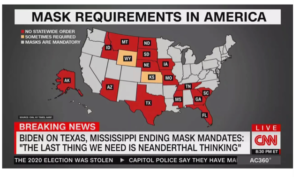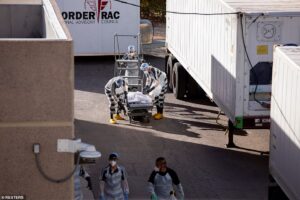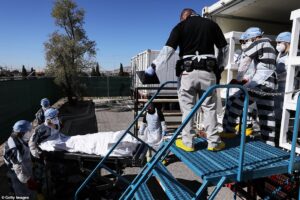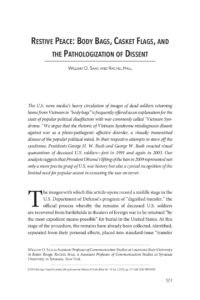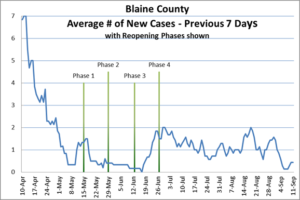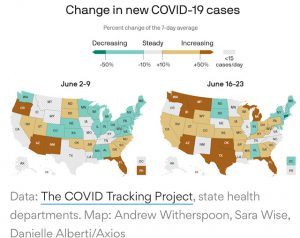Dr. Fauci
Idaho’s Dr. Fauci
March 4, 2021Dr. David Pate serves on the Idaho COVID task force. He is the former President & CEO of St. Luke’s Health, receiving an MD in internal medicine from Baylor College of Medicine, and a JD in health from University of Houston Law Center.
Many of us who live in Idaho are exhausted by a politically polarized legislature, none more than Dr. Pate who continually puts the health of Idahoans first, while the state legislature does not. (Many whom are less than intellectually sound and gravitate to red hats, but, hey, that’s a personal take.)
Here is a recent thread from Dr. Pate’s twitter feed as we head into a potential fourth wave of COVID while states like Mississippi and Texas reverse mask mandates and open businesses. Idaho just introduced legislation this week that would eliminate mask mandates in certain communities, like Blaine County and McCall. Governor Brad Little never implemented a state-wide mask mandate. -dayle
Dr. Pate:
As Idaho Republicans keep introducing bills, I have to continue to rearrange to a new one to the list of stupidest bills. This is ridiculous. Legislation Introduced That Would ban Mask Mandates in Idaho.
~
I warned school board members in the middle of February: Please don’t commit to bringing students back for full in-person classes given admin admitted that we would have to decrease physical distancing. I warned that the UK variant behaves differently in schools and it is likely to become the dominant strain right as you plan to bring all these students back. At that time, the UK variant accounted for about 1% of cases. Today, just two weeks later it accounts for an estimated 10% of cases.
That is a doubling time of 5.6 days.
Using some simple math – with West Ada’s plan to bring everyone back in 26 days – that would mean 4.5 more doubling times = the UK variant will indeed be the predominant strain, in fact, unless we find that one of the other variants (maybe the California variant?), out-competes it, it will completely replace the previous variants on which their whole operating plan was based. I should know- I wrote it.
This variant [P1] has shown up next door, Idaho. I guarantee you this is not the time to give up masks & physical distancing, & I have no idea why elected leaders think we should have larger gatherings. Brazil’s Covid Crisis Is a Warning to the Whole World.
Brazil’s Covid Crisis Is a Warning to the Whole World, Scientists Say
Brazil is seeing a record number of deaths, and the spread of a more contagious coronavirus variant that may cause reinfection.
Dr. Pate can be heard on Boise State Public Radio’s ‘Idaho Matters’, every Wednesday, KBSX radio, or online streaming. Also available via podcast.
https://www.boisestatepublicradio.org/#stream/0
~
From the Washington Post this afternoon, 3.4.21:
Health officials continue to criticize Texas and Mississippi’s moves to rescind mask mandates and let businesses operate at full capacity.
The nation’s top infectious-disease expert, Anthony S. Fauci, called the choices “ill-advised,” while some local officials begged residents to keep wearing face coverings. Previously plummeting infection totals in the United States have stalled in recent days, possibly because in part to the spread of more contagious variants.
Many businesses in Texas and Mississippi were quick to remove their “masks required” signs, but some of the country’s biggest retailers – including Target and Starbucks – said they would continue to mandate masks in their Texas stores to protect front-line workers and customers.
Meanwhile, Europe is also experiencing an end to six weeks of declining case numbers as the virus mounts an unwelcome resurgence. New cases have risen by 9 percent in the past week, with central and eastern Europe impacted the most. World Health Organization officials attributed some of the increase to a more contagious variant, first detected in the United Kingdom, that is driving an outbreak in the Czech Republic and Hungary.
~
From Dr. Anthony Fauci:
Public health officials have been warning of a possible fourth wave of the pandemic should the nation let its guard down, especially since the seven-day average of new cases remains at roughly 65,000 in the U.S.
“I don’t know why they’re doing it, but it’s certainly from a public health standpoint ill-advised.” If you look at, right now, the curves of the diminution of infections that are going down, it’s reached the point where the last seven days have plateaued. We’ve been to this scene before, months and months ago when we tried to open up the country and open up the economy, when certain states did not abide by the guidelines, we had rebounds that were very troublesome.”
Earlier in the day, Centers for Disease Control and Prevention Director Rochelle Walensky acknowledged that a year of restrictions was helping to fuel a worrisome change in behavior.
“Stamina has worn thin,” Walensky said during a press briefing Wednesday morning. “Fatigue is winning, and the exact measures we have taken to stop the pandemic are now too often being flagrantly ignored.” [Yahoo News]
Show the bags, not the graphs.
November 16, 2020Don’t show the COVID graphs, show the COVID victim body bags. -dayle
‘The U.S. news media’s heavy circulation of images of dead soldiers returning home from Vietnam in “body bags” is associated with popular political disaffection with war commonly called “Vietnam Syndrome.”’
[Texas Images: Getty/Rueters]
Restive Peace: Body Bags, Casket Flags, and the Pathologization of Dissent
Abstract
The U.S. news media’s heavy circulation of images of dead soldiers returning home from Vietnam in “body bags” is frequently offered as an explanation for the state of popular political disaffection with war commonly called “Vietnam Syndrome.” We argue that the rhetoric of Vietnam Syndrome misdiagnoses dissent against war as a photo-pathogenic affective disorder, a visually transmitted disease of the popular political mind. In their respective attempts to stave off the syndrome, Presidents George H. W. Bush and George W. Bush enacted visual quarantines of deceased U.S. soldiers—first in 1991 and again in 2003. Our analysis suggests that President Obama’s lifting of the ban in 2009 represented not only a more precise grasp of U.S. war history but also a cynical recognition of the limited need for popular assent in executing the war on terror.
“The number of coronavirus cases in the United States passed 11 million on Sunday. It took 100 days for the nation to log its first 1 million cases; it took just six days to get from 10 million to 11 million. The number of people being hospitalized with covid-19 is also higher. Fearing that the worsening crisis will lead to even more preventable deaths.”
CNN
U.S.
11,163,990 Cases
246,953 Deaths
CNBC/11.16.20
‘Dr. Anthony Fauci warns “it’s not going to be a light switch” back to normalcy even when a Covid-19 vaccine becomes available to the public.
In fact, Fauci recommends people still wear masks and practice social distancing even after getting the vaccine, he told CNN’s Jake Tapper on “State of the Union” on Sunday.
Because “even though, for the general population, it might be 90[%] to 95% effective,” said Fauci, “you don’t necessarily know, for you, how effective it is.” Even at those success rates, about 5% to 10% of people immunized may still get the virus.
“In addition, the protective effect of a vaccine may take at least one month, if not slightly longer,” says Dr. David Ho, a virologist working on developing monoclonal antibody therapies for Covid-19 at Columbia University. (So far, Pfizer said early results showed its two-dose vaccine showed 90% effectiveness seven days after the second dose. Early data on Moderna’s two-dose vaccine showed 94.5% efficacy two weeks after the second dose.)
“Therefore, for the foreseeable future, we will need to continue our mitigation measures, including wearing masks,” Ho says, noting that precautionary measures will likely last “for much of 2021.”
Dr. Bruce Hirsch, an infectious disease specialist at Northwell Health, adds that many people have strong feelings about vaccines and may not take them, which “will impact the general population from being immune to Covid-19 and prolong the threat of the pandemic.”
Fauci predicted to Tapper that most of the country will get vaccinated in the second or third quarter of 2021.
But “we are not going to turn [the pandemic] on and off, going from where we are to completely normal. It’s going to be a gradual accrual of more normality as the weeks and the months go by, as we get well into 2021,” he said.’
💉
September 13, 2020Eye On Sun Valley
“Dr. Anthony Fauci calls it the most important flu shot you will ever get.”
Health officials recommend you get a flu shot any time after Sept. 15 into early October. Only 47% of Americans got the flu vaccine last year—Idaho ranked 4th lowest in the nation for children flu vaccination [American Academy of Pediatrics.] Rhode Island has the highest rate with 76 percent.
Health officials want to avoid a twindemic, in which those sick with flu will inundate health clinics and hospitals at the same time people are seeking care for COVID.
Or, worse yet, cases in which someone contracts both COVID and flu at the same time.
Having flu makes one more susceptible to getting COVID. And getting both could be exponentially more serious, as both can cause pneumonia, respiratory inflammation of the heart, brain or muscle tissues and other maladies.
https://eyeonsunvalley.com/Mobile/Mobile_Story_Reader?StoryId=7604
Blaine County Idaho’s seven-day moving average remains low with just 0.4 cases per day on average, says Paul Ries.
Only 45% of American’s wear masks to guard against COVID.
One perpetual wave.
June 25, 2020U P D A T E
WASHINGTON POST/Thursday, June 25th
State health departments reported 38,115 new infections on Wednesday, the highest single-day caseload in the United States since the pandemic began. As for the total, true number of infections, CDC Director Robert Redfield said Thursday: “Our best estimate right now is that for every case that’s reported, there actually are 10 other infections.”
The new spike was caused by a rush to reopen without proper safety measures in place, infectious-disease experts say, and the push to do so, even as cases climb, sends a dangerous and inaccurate message.
AXIOS
‘A nationwide crisis, made worse by a vacuum of political leadership, threatening to overwhelm hospitals.’
The pandemic is getting dramatically worse in almost every corner of the U.S., Axios health care editor Sam Baker and visual journalist Andrew Witherspoon report.
- ⚡ This is the grimmest map in the eight weeks since Axios began tracking the state-by-state change in new cases.
-
- Nationwide, cases are up 30% compared to the beginning of this month
- Dramatically worsening outbreaks in several states are beginning to strain hospital capacity — the same concern that prompted the nationwide lockdown in the first place.
- Over half the country — 26 states — has seen its coronavirus caseloads increase over the past week.
Trying to unpack this logic:
Governor Brad Little, (R) Idaho, will not mandate masks because “compliance would be terrible.”
Boise (Ada County) COVID numbers, like in Arizona, California, Texas, and Florida, continue to exponentially increase.
From Boise State Public Radio [KBSX] reporter Heath Druzin:
On the day the governor says Idaho is not meeting its #COVID19 goals, and in the midst of a local outbreak, just saw a @CityOfBoise employee pull up in a city car and walk into a gas station store with no mask. So that’s how seriously we’re taking the pandemic right now.
More from Heath:
Idaho saw its highest number of lab-confirmed COVID-19 cases in a single day Wednesday, with 223 and another 20 probable cases. There was also an additional death, bringing the state’s total to 90.
⬆️
Wednesday’s total includes 101 cases in Ada County, which is in the midst of a spike, with some tied to downtown bars where patrons did not practice physical distancing. In response, Central District Health has ordered bars in the county to close again and the county to return to Phase 3 of reopening.
There have been 908 cases over the last seven days, representing by far the worst week for COVID-19 infections in Idaho since the pandemic began in March. In addition, Idaho Gov. Brad Little announced the first confirmed infection of an inmate at an Idaho correctional center.
https://www.boisestatepublicradio.org/post/idaho-sees-highest-one-day-covid-19-total
Vacation bookings are up in the Mountain West with folks looking for outdoor escape from their own dramatically increasing COVID numbers. Guides report a record increase in bookings. From Eye On Sun Valley:
Silver Creek Outfitters’ three dozen fishing guides have seen a record number of requests for guided fishing outings this summer from out-of-state visitors eager to escape coronavirus lockdowns.
While grateful for the extra business, it does present a conundrum for some.
“Terry Ring has put a whole lot of precautions in place and fly-fishing is an activity in which you can social distance,” said fishing guide Bob Knoebel. “But, while I feel confident with most of the people in the valley, I’m not as comfortable with people from outside the valley because I have no idea where they’ve been and who they’ve been with.
From CDC website. (A reminder to consider the source.)
“Do we need to get a flu vaccine earlier this year (i.e. July/August)?
While the Advisory Committee on Immunization Practices has not yet voted on the flu vaccine recommendations for 2020-2021, CDC does not anticipate a major change in the recommendation on timing of vaccination. Getting vaccinated in July or August is too early, especially for older people, because of the likelihood of reduced protection against flu infection later in the flu season. September and October are good times to get vaccinated. However, as long as flu viruses are circulating, vaccination should continue, even in January or later.
Will there be changes in how and where flu vaccine is given this fall and winter?
How and where people get a flu vaccine may need to change due to the COVID-19 pandemic. CDC is working with healthcare providers and state and local health departments to develop contingency plans on how to vaccinate people against flu without increasing their risk of exposure to respiratory germs, like the virus that causes COVID-19.
Some settings that usually provide flu vaccine, like workplaces, may not offer vaccination this upcoming season, because of the challenges with maintaining social distancing. For more information on where you can get a flu vaccine, visit www.vaccinefinder.govexternal icon.”
CNBC
The National Institutes of Health has been fast-tracking work with biotech firm Moderna on a potential vaccine to prevent Covid-19, which has infected more than 6.28 million people worldwide and killed at least 375,987, according to data compiled by Johns Hopkins University.
Dr. Anthony Foci said earlier this month that the biotech company expects to enroll about 30,000 individuals when it begins a phase 3 trial in July. He said there are at least four trials for potential vaccines that he is either directly or indirectly involved in.
Fauci said that by the beginning of 2021 “we hope to have” hundreds of millions of doses.”
When asked whether scientists will be able to find an effective vaccine, Fauci said he’s “cautiously optimistic,” adding that “there’s never a guarantee.” He cautioned “it could take months and months and months to get an answer” before scientists discover whether the vaccine works.
U.S. officials and scientists are hopeful a vaccine to prevent Covid-19 will be ready in the first half of 2021 — 12 to 18 months since Chinese scientists first identified the coronavirus and mapped its genetic sequence.
It’s a record-breaking time frame for a process that normally takes about a decade for an effective and safe vaccine. The fastest-ever vaccine development, mumps, took more than four years and was licensed in 1967.
However, scientists still don’t fully understand key aspects of the virus, including how immune systems respond once a person is exposed. The answers, they say, may have large implications for vaccine development, including how quickly it can be deployed to the public.
C-SPAN
Dr. Fauci stestifying earlier this week in Washington D.C. on the federal pandemic response.
